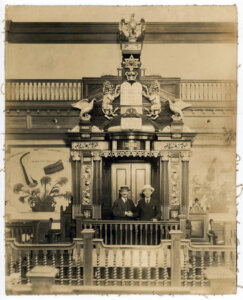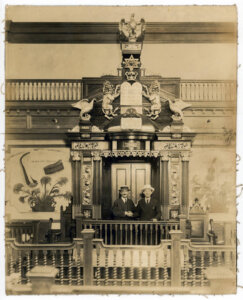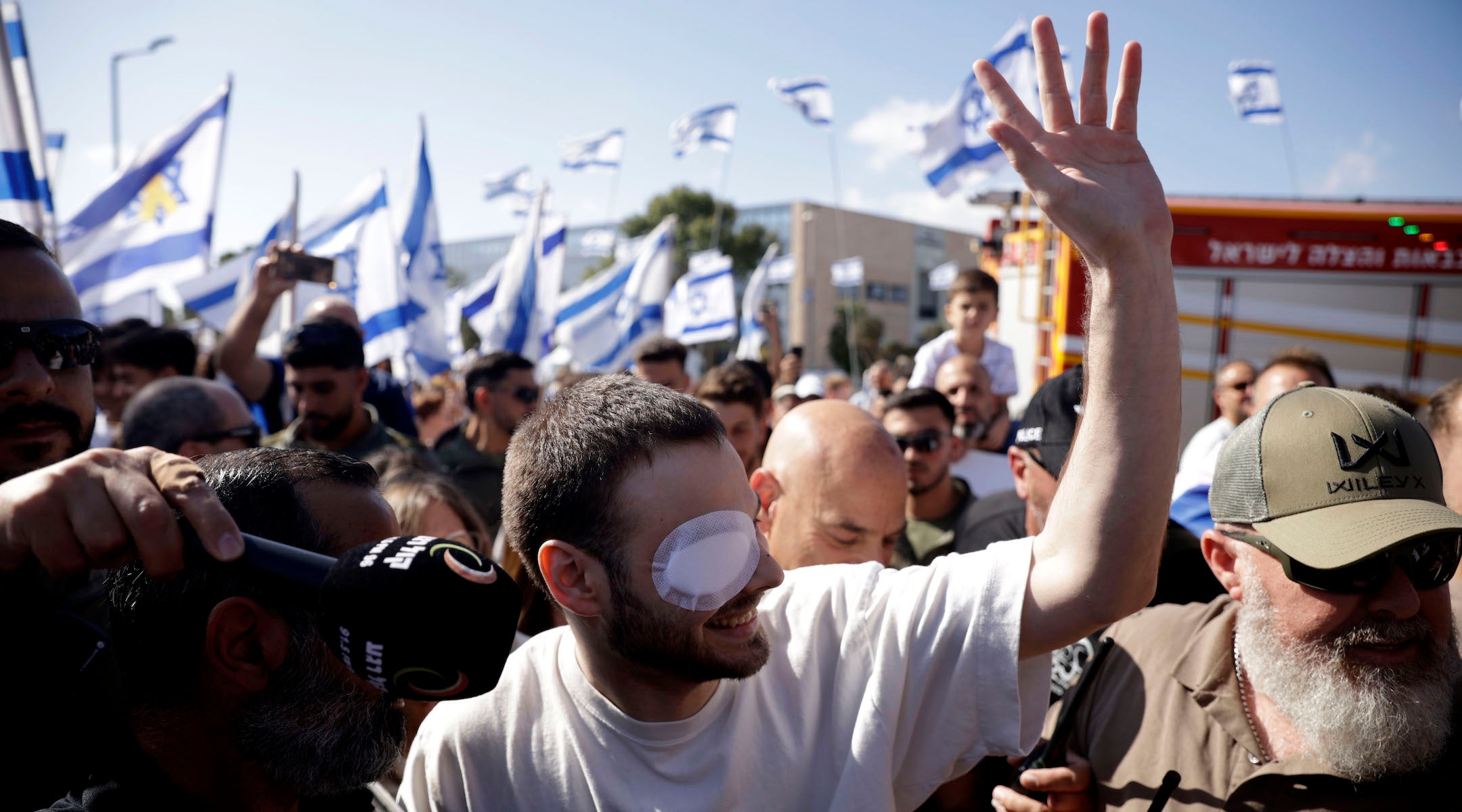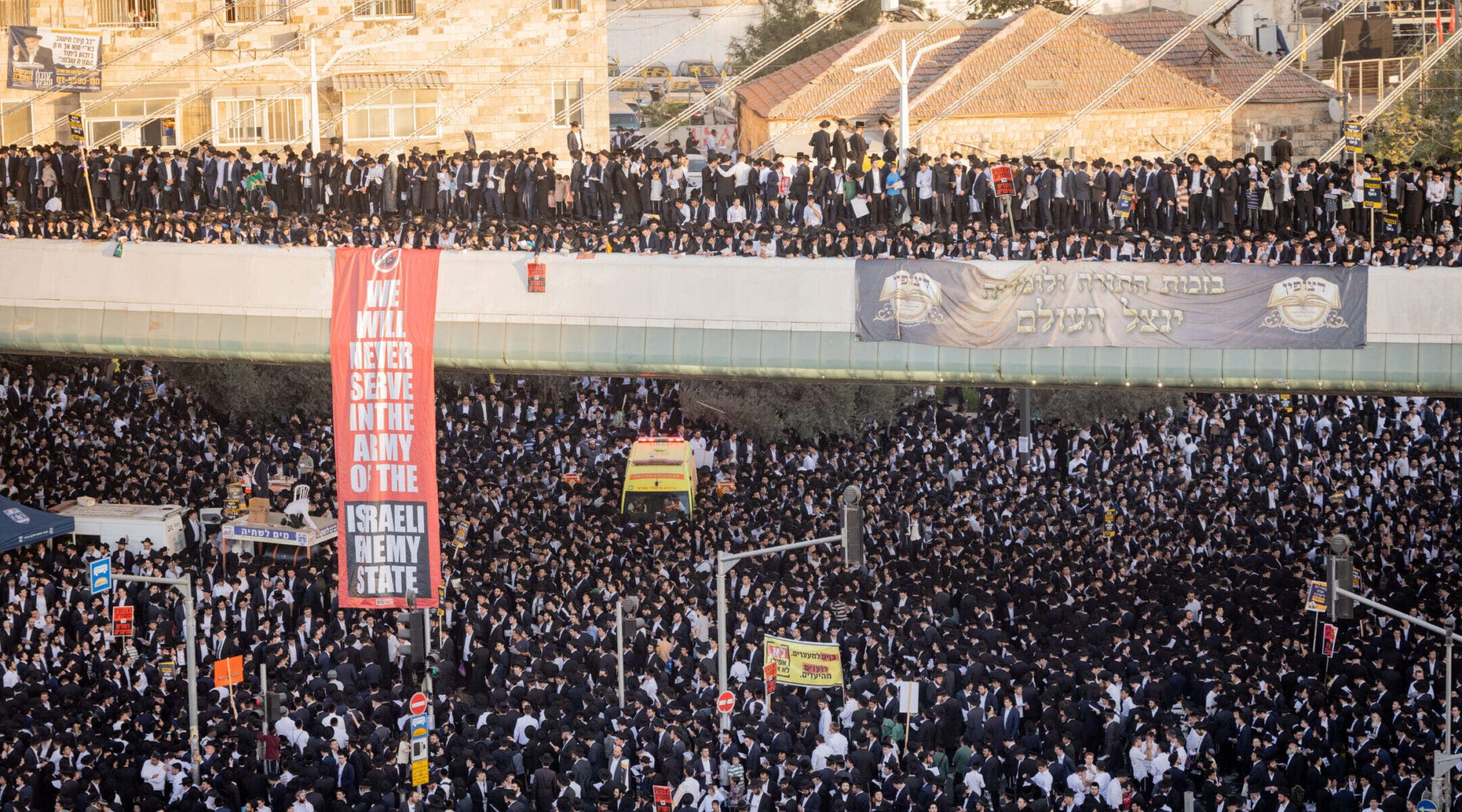Uncategorized
How a curator and a rabbi joined forces to keep a piece of Boston’s Jewish history alive

The most striking artifact in the Judaica collection at Boston’s Museum of Fine Arts isn’t from Yemen or Galicia, or any other far-flung Jewish community that’s long since dispersed; it’s from Chelsea, Massachusetts.
The magnificent wooden Torah ark is just shy of 12 feet tall, and until 1999 it was the centerpiece of the Orange Street Synagogue, in Chelsea, a suburb that once teemed with so much Jewish life it earned the nickname ‘Little Jerusalem.’
But with American synagogues now closing at a record pace, the arks and facades and stained glass windows that testified to American Jewry’s dynamism face an unsettled future.
Indeed, to make the short hop from Chelsea to northeast Boston, the MFA’s ark took a rather scenic — even biblical — route. There’s a last-gasp reprieve as destruction looms; an extended stint in a wilderness of sorts (Texas); and a healthy sprinkling of rabbinic wisdom.
All the same, it illuminates an often forgotten chapter in Boston’s Jewish story.
A thriving Jewish enclave
Around the turn of the 20th century, tens of thousands of mostly eastern European Jewish immigrants arrived in Chelsea, transforming a provincial Protestant outpost into a chiefly working-class center of Jewish cultural, religious and economic life. By 1920, it had between 15 and 20 synagogues; a Hebrew School that graduated over 400 people a year; and dozens of clubs and organizations that held their meetings in Yiddish.
One of its more well-known inhabitants was Sam Katz, a Galician immigrant who was, for a time, Massachusetts’ pre-eminent woodcarver. Katz was born in 1884 in Veshnevets, modern Ukraine, and emigrated to the US in 1910. He lived briefly in New York before settling in Greater Boston, where, even though he lacked formal training, he built an estimated 24 synagogue arks during the 1920s and 30s. “These immigrant wood carvers, in general, learned from their father and their grandfather,” said Simona Di Nepi, curator of the MFA’s Judaica collection.
Still, Katz found his own style. “When I see vine leaves and grates and these kinds of lions,” Di Nepi told me, pointing to a pair of gilded lions affixed to either side of the MFA’s ark, “I know that it’s Sam Katz.” Perched on top of the ark is a bald eagle, jostling for position with a Torah crown. Taken together, said Di Nepi, the sculptures are a kind of shorthand for the burgeoning Jewish-American culture Chelsea represented. Indeed, this is one of the gallery’s abiding themes: the various ways artists have combined age-old Jewish iconography with time- and place-specific motifs.

The ark needs a hero
By 1950, Jewish Chelsea had entered a terminal decline. Many of its inhabitants had moved to tonier Boston suburbs like Brookline or Newton, propelled by improving socio-economic mobility, though the construction of the Tobin Bridge between 1947 and 1950 also pushed out some 250 families and effectively split the Jewish community in two. In early 1999, the Orange Street Katz Torah ark closed for a final time, its fate uncertain.
That’s when rabbi David Whiman, a congregational rabbi in nearby Newton, and an avid Judaica collector, stepped in.
Whiman salvaged the ark alongside a small crew of friends. A small screen in the gallery plays grainy footage of Whiman in an oversized white T-shirt, smiling broadly. Though the Orange Street shul pews are empty, and the work laborious, Whiman and his group appear noticeably upbeat. The opportunity to preserve such an invaluable link to Chelsea’s Jewish past is, clearly, a happy one. (Whiman, rabbi emeritus at North Shore Synagogue, did not respond to an inquiry.)
Whiman kept the ark with him as his rabbinical career took him first to Houston, where he stayed for the better part of decade, and, later, to Syosset, Long Island. And then, at the height of the COVID-19 pandemic, he emailed Di Nepi. He had heard the MFA was establishing a permanent Judaica collection. “He initially said, ‘I’m a collector, and you can have anything you want,’” Di Nepi recalled. In 2022, she went to Syosset, and was immediately taken with the ark. “There were other things that I might have been interested in,” she said, “but this was so much a Boston story — a local story.”
The ark bore the scars of nearly 20 years in storage. “All the attached pieces were in a box,” Di Nepi said. “And the wood had marks all over it.” Over six months, the MFA’s Conservation department, led by Christine Storti, restored the ark’s original flourishes: On top, an eagle and a torah crown; just below, two golden lions and three Magen Davids; and, in the middle, two gilded hands of Kohanim clasped together in prayer. Di Nepi then placed the renovated ark on a bimah-esque plinth, where it remains today, resplendent in the dim gallery light.
For every rescued Torah ark, however, are dozens that couldn’t overcome the demographic and cultural changes that have reshaped American Judaism during the past half-century. “There used to be a high demand for Torah arks,” Di Nepi said. “But now, we have the inverse situation, where there is mass demand for finding homes for arks that are closing.”
The Sam Katz ark is therefore a monument to a community that’s largely slipped from view. Yet there’s one fragment of Jewish Chelsea that’s proved remarkably durable. The glass light bulb Katz hung from the ark more than a century ago still works, Di Nepi told me, though she and Storti opted against displaying it, given its obvious fragility, and commissioned a replica. I am nevertheless consoled by the thought that somewhere in the Museum of Fine Arts’ storage there’s a tiny piece of Jewish Chelsea, waiting to shine again.
The post How a curator and a rabbi joined forces to keep a piece of Boston’s Jewish history alive appeared first on The Forward.
Uncategorized
‘New Gaza’ Rises: Anti-Hamas Militias Backed by Israel Claim Local Rule, Vow to Fight Qatar, Turkey, Iran Forces

Smoke rises in Khan Younis, southern Gaza Strip, Oct. 30, 2025. Photo: REUTERS/Ramadan Abed TPX IMAGES OF THE DAY
As Gaza’s ceasefire holds uneasily, four Israel-backed militias fighting Hamas are moving to fill the power vacuum, pledging to cooperate with most international forces involved in rebuilding the enclave but vowing to resist any presence from Qatar, Turkey, or Iran, The Algemeiner has learned.
The militias, mainly in southern Gaza, are not part of US President Donald Trump’s proposed plan for a technocratic administration in the enclave.
Based in Khan Younis, Hossam al-Astal, commander of the Counter Terrorism Strike Force, said his group and three allied militias had coordinated in recent weeks to secure areas vacated by Hamas, the terrorist group that until the latest with Israel had solely ruled Gaza since 2007, and were ready to take on civil and security responsibilities once reconstruction begins.
“We are capable of building [a] government in our areas,” al-Astal said over a Zoom call on Wednesday, adding that his group already had the “human resources” to do so.
“We are ready to cooperate with international forces and with others on the ground,” he said. “The enemy of my enemy is my friend.”
But he went on to say that his clan would not accept any Muslim Brother-affiliated forces, citing Qatar, Turkey, and Iran. “We will view forces from those countries as hostile, and we will fight them just as we fight Hamas.”
Hamas, the Palestinian branch of the Muslim Brotherhood’s global Islamist network, has received military, financial, diplomatic, and political backing for years from Qatar, Turkey, and Iran.
In the Trump-brokered ceasefire deal to end the war and release the hostages kidnapped from Israel by Hamas-led terrorists, Israeli forces pulled back to a notional demarcation called the “yellow line,” marking roughly half the Gaza Strip as under Israeli control. The Israel Defense Forces (IDF) has begun placing yellow concrete blocks and signposts every 200 meters to mark the boundary and issued orders that anyone crossing it may be fired on.
On Tuesday, IDF reservist Master Sgt. (res.) Yona Efraim Feldbaum was killed when Palestinian terrorists attacked troops near the southern city of Rafah. The IDF retaliated by striking dozens of terrorist targets, it said.
Some counter-terrorism experts have argued that the rise of local militias makes both the disarmament of Hamas and the safe entry of reconstruction teams far more difficult.
Matthew Levitt, director of a counterterrorism program at the Washington Institute for Near East Policy, said in Foreign Affairs magazine that Hamas “will fight tooth and nail to maintain its political and military position in Gaza.”
Trump’s son-in-law and senior adviser Jared Kushner told reporters last week that “no reconstruction funds will be going into areas that Hamas still controls,” he said. “There are considerations being discussed now in the areas the IDF controls, as long as they can be secured to start building the new Gaza.”
The term “New Gaza” is frequently used by al-Astal, and refers to what he described as a joint framework for the territory’s governance between his Counter Terrorism Strike Force and the three allied clans led by Yasser Abu Shabab in Rafah, Rami Halas, and Ashraf al-Mansi, the latter two both in Gaza City. Tens of thousands of Palestinians are estimated to be living in those areas.
During the Zoom call, which was organized by the Center for Peace Communications, a New York-based group that documents dissent inside Gaza, a journalist who identified himself as Ahmed al-Zakout described conditions in Hamas-controlled areas west of the yellow line. Since the ceasefire, more than 100 executions have been carried out by Hamas against Gazans accused of being collaborators with Israel, as well as large numbers of maimings. Disappearances and abductions are also estimated to number in the hundreds.
Al-Zakout said residents in his area had initially believed the agreement announced by Trump would remove Hamas from power — and explained that hope had already collapsed. “People are very afraid,” he said. “They are shocked and disappointed to see Hamas remain here in our areas.”
According to al-Zakout, many civilians were afraid to try to reach territory on the other side of the yellow line, because they believed they could be targeted while moving. He said no authority — “not America or even Israel” — was publicly guaranteeing safe passage, and he blamed Hamas messaging for deterring people from leaving. He singled out Qatar’s Al Jazeera network as part of what he called “a propaganda effort designed to scare people away from the other side of the yellow line, to intimidate them and ensure that they stay where they are.”
“We see obvious collaboration and coordination between the message of Hamas [and] the message of Al Jazeera. Al Jazeera portrays every civilian trying to get to [the] yellow side and to safety as [an] agent and collaborator with Israel. They are spreading a lot of propaganda.”
Uncategorized
Freed hostage Alon Ohel plays piano on Israeli sketch comedy show ‘Eretz Nehederet’

The Israeli sketch comedy show “Eretz Nehederet” is famous for parodying every aspect of Israeli politics and culture. But the smiles were sincere on Wednesday night when a special guest took the stage: freed hostage Alon Ohel.
Throughout his two-year captivity, Ohel became widely known for his prowess on the piano. And earlier this year, the cast of the show sang a tribute to him with the Israeli singer Hanan Ben Ari, as part of a national campaign to keep attention on the hostages being held in Gaza.
On Wednesday’s episode, Ohel grinned as he played a rendition of Israeli singer-songwriter David Broza’s “Under the Sky.” An eyepatch covered his right eye, following an injury that was left untreated after he was taken hostage on Oct. 7, 2023.
“We came here, from under the sky, two – like a pair of eyes, we have time, under the sky, in the meantime – we’re still here,” read the lyrics of the song, translated from Hebrew.
He was surrounded by his parents and sister as well as the show’s cast. “It was a moment the whole world had been waiting for, and not a single eye was left dry,” the Hostage and Missing Families Forum said in a post on Facebook.
Since the remaining 20 living hostages were released from Hamas captivity earlier this month as part of a U.S.-brokered ceasefire deal, their emergence into public view has drawn emotional celebrations from Israelis.
On Friday, freed hostage Nimrod Cohen attended a memorial service at the Kfar Saba military cemetery for Staff Sgt. Oz Daniel, who was killed in Cohen’s unit on Oct. 7 and whose body has not yet been released during the ceasefire deal.
On Sunday, former hostages Segev Kalfon, Eitan Mor, Evyatar David and Guy Gilboa-Dalal were met with parades as they returned to their homes after being released from Beilinson Hospital, which has shuttered its “Returning Hostages Ward.”
Some of the viral videos of the former hostages have captured their brushes with celebrity, including with Ben Ari, who sang with several of them while they were hospitalized.
Eli Sharabi, who was released in February to learn that his wife Lianne and daughters Noiya and Yahel were murdered on Oct. 7, walked the runway at Tel Aviv Fashion Week on Sunday where he was joined by the relatives of other freed hostages.
The following day, Sharabi’s brother, Yossi, who was killed in Hamas captivity in January 2024 and whose remains were returned to Israel as part of the ceasefire deal earlier this month, was buried in central Israel.
Sharabi said the funeral was “the beginning of delayed justice. Our hearts are broken but our heads are held high.”
—
The post Freed hostage Alon Ohel plays piano on Israeli sketch comedy show ‘Eretz Nehederet’ appeared first on Jewish Telegraphic Agency.
Uncategorized
Hundreds of thousands of haredi Jews protest in Jerusalem against Israeli military draft

Hundreds of thousands of haredi Orthodox Jewish men joined a mass protest in Jerusalem on Thursday to rail against the Israeli government’s efforts to enlist yeshiva students into the military.
The mass prayer demonstration, called the “Million Man March,” was organized by the leaders of Israel’s different ultra-Orthodox groups in response to a spate of arrests of yeshiva students who had dodged the Israeli draft.
“The debate over the law is still ongoing, and it belongs in the Knesset,” one organizer told Haaretz. “If that were the only issue, we wouldn’t hold a rally. But following the arrests of yeshiva students and the persecution against us, it was decided to protest nonetheless.”
The protest comes one year after the Israeli Supreme Court unanimously ruled that Israel must draft haredi Orthodox Jews into its army, a decision welcomed by many Israelis who believe the haredi sector was not bearing its share of the burden of the war in Gaza. The ruling renewed demonstrations from haredi groups who have long argued that they should be exempt for religious reasons.
Earlier this month, upwards of 10,000 haredi Orthodox Jewish men staged another protest in New York City to oppose the draft.
At the demonstration Thursday, two ultra-Orthodox soldiers, a police officer and several journalists were attacked by protesters, including Channel 12 News reporter Inbar Twizer who had objects thrown at her during her broadcast.
Throughout the day, hundreds of protesters were seen entering construction sites, scaling roofs and climbing cranes. One 15-year-old boy died after falling from the 20th floor of a high-rise construction site.
One group of protesters were also seen carrying a banner from the Hostages and Missing Families Forum, which read, “Bringing back the hostages, bringing back hope.” The group has previously pursued legal action against a yeshiva that appropriating symbols for the hostages to rally for the release of jailed yeshiva students.

Israeli security forces disperse ultra-Orthodox Jewish men during a protest against conscription into Israel’s military in Jerusalem on October 30, 2025. (Fadel SENNA / AFP)
After the protests’ organizers called for an end to the demonstration on Thursday evening, some protesters remained near the entrance of Jerusalem and clashed with Israeli border police, according to the Times of Israel.
—
The post Hundreds of thousands of haredi Jews protest in Jerusalem against Israeli military draft appeared first on Jewish Telegraphic Agency.


